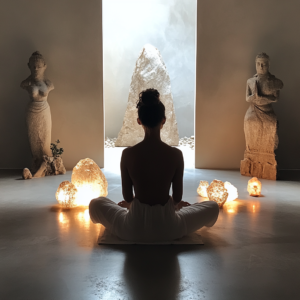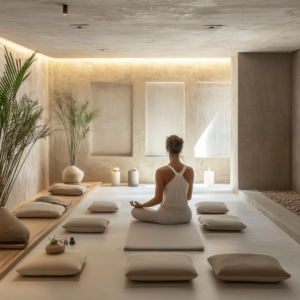1. Introduction
Stoic Meditation: Blending Ancient Wisdom with Modern Practices is a transformative journey toward emotional resilience and mental clarity. In today’s hectic world, stress and unresolved emotions often cloud our thinking, leaving us overwhelmed by the constant pressures of modern life. This guide invites you to explore how integrating time-tested stoic principles with contemporary meditation techniques can help you release emotional burdens and achieve a balanced, focused mind.
The Challenge of Modern Life
Every day, our minds are bombarded with endless distractions—from digital noise to relentless deadlines—which can lead to mental clutter and emotional strain. Recognizing the impact of these stressors is the first step in reclaiming your inner peace. By turning inward and cultivating mindfulness, you can create space for clarity and calm even amid chaos.
Embracing Ancient Wisdom
The wisdom of ancient stoic philosophers offers timeless insights into overcoming adversity and finding inner strength. Their teachings encourage us to observe our thoughts without judgment, fostering a perspective that helps release negativity. This ancient guidance, when combined with modern meditation practices, lays a solid foundation for transforming your mental state and achieving lasting emotional freedom.
Setting Your Intentions
Before beginning your practice, it’s important to set clear, personal intentions. Reflect on what it means to let go of emotional baggage and how a clear mind can empower you to live more fully. Establishing these goals will serve as your roadmap, guiding each session and ensuring that every moment spent in meditation moves you closer to a balanced and resilient state.
An Invitation to Begin
We invite you to embark on this journey of transformation. With patience, commitment, and an open heart, you can learn to clear your mind and release what no longer serves you. For additional guidance on nurturing mindfulness in everyday life, visit our article on Mindful Living: 7 Daily Habits to Boost Wellbeing.

2. The Foundations of Stoic Meditation
Stoic meditation is built upon the timeless wisdom of ancient philosophers who believed that a clear, rational mind was essential for a virtuous life.
Embracing the Stoic Philosophy
The practice of Stoic meditation teaches you to observe your thoughts and emotions without judgment. This foundational principle enables you to distinguish between what you can control and what lies beyond your influence. Such clarity is the heart of Stoic Meditation: Blending effective techniques with timeless philosophy.
Cultivating Inner Resilience
A major aspect of this practice is developing resilience through reflective self-examination. By regularly contemplating your actions and responses, you learn to let go of negative emotions and embrace a more balanced perspective. This inner work is central to achieving Stoic Meditation: Blending in daily life.
3. Neurobiological Insights into Stoic Meditation
Modern neuroscience offers compelling evidence on how meditation can reshape the brain for improved focus and emotional regulation.
Brain Structure and Function
Studies using brain imaging technologies (such as fMRI and EEG) have revealed that regular meditation can increase grey matter density in areas responsible for memory, attention, and emotional regulation. This scientific breakthrough underpins the transformative power of Stoic Meditation: Blending ancient wisdom with modern research.
Neurotransmitter Regulation
Meditation also influences neurotransmitter levels, helping to balance chemicals like serotonin and dopamine. This regulation plays a crucial role in mood stabilization and cognitive clarity, further validating the benefits of Stoic Meditation: Blending practices in maintaining a healthy mind.
4. Psychological and Emotional Benefits
In addition to its neurobiological effects, Stoic meditation offers significant psychological advantages.
Enhancing Focus and Cognitive Function
Regular practice helps improve attention span and working memory by training the brain to remain present. Over time, these improvements lead to sharper mental focus and greater productivity, illustrating the practical benefits of Stoic Meditation: Blending traditional wisdom with modern techniques.
Reducing Anxiety and Depression
Numerous clinical studies have demonstrated that meditation can significantly reduce symptoms of anxiety and depression. By promoting a state of calm and reducing negative thought patterns, this practice empowers you to experience true emotional balance—a key outcome of Stoic Meditation: Blending.
Fostering Emotional Resilience
By observing your emotions without becoming overwhelmed, you develop a more resilient mindset. This emotional strength enables you to respond to life’s challenges with clarity and composure, showcasing the transformative potential of Stoic Meditation: Blending.
5. Establishing a Consistent Meditation Routine
A sustainable routine is essential for reaping the long-term benefits of Stoic meditation.
Creating Your Meditation Space
Select a quiet, comfortable space where you can practice without interruptions. Whether it’s a dedicated corner of your home or a serene outdoor setting, this space will serve as your personal sanctuary. Such an environment reinforces your commitment to Stoic Meditation: Blending principles and provides the ideal backdrop for deep reflection.
Setting a Daily Schedule
Consistency is key to developing a meditation habit. Allocate a specific time each day for your practice—even if it’s just 15 to 20 minutes initially. Regular sessions help build momentum and ensure that you steadily work toward the benefits of Stoic Meditation: Blending.
Guided Meditation Sessions
For those new to the practice, guided sessions can provide invaluable support by offering clear, step-by-step instructions. These sessions enable you to focus on proper breathing and posture, laying a strong foundation for achieving Stoic Meditation: Blending.
For additional tips on establishing your routine, visit our article on Mindful Living: 7 Daily Habits to Boost Wellbeing.

6. Practical Techniques for Mental Clarity
Delving into specific techniques can help you clear mental clutter and achieve the calm state needed for emotional freedom.
Mindful Breathing
Begin with slow, deliberate breathing exercises. Inhale deeply, hold briefly, and exhale slowly—this practice calms the mind and sets the stage for a focused state, central to Stoic Meditation: Blending.
Body Scan Meditation
Performing a body scan helps you become aware of and release physical tension, which in turn reduces mental stress. This technique is fundamental in cultivating the clarity and calm that define Stoic Meditation: Blending practices.
Guided Visualization
Spend a few minutes visualizing peaceful imagery or successful outcomes to shift your mental state from anxiety to tranquility. Visualization is a powerful tool that assists in achieving Stoic Meditation: Blending by reducing negative thought cycles.
Digital Guidance
For a practical demonstration, digital resources such as YouTube provide guided sessions. For example, The Honest Guys YouTube channel offers immersive videos that exemplify how to practice these techniques effectively.

If you’ve already discovered life-changing insights in The Power of Visualization eBook, now’s the time to accelerate your progress with the fully narrated, step-by-step video update. I’m excited to share a special offer that’s not available anywhere else.
7. Integrating Stoic Meditation into Daily Life
Incorporating Stoic meditation into your everyday activities can transform your overall lifestyle, leading to improved mental clarity and emotional freedom.
Embedding Mindfulness in Routine Tasks
Simple mindfulness practices, such as focusing on your breath while commuting or during a work break, can help you maintain a calm and centered state throughout the day. This integration makes Stoic Meditation: Blending a seamless part of your daily life.
Balancing Work and Relaxation
Creating a balance between productivity and rest is crucial for maintaining mental clarity. Scheduling brief meditation breaks during your workday can help reduce stress and enhance focus, embodying the philosophy of Stoic Meditation: Blending.
Internal Link
For more insights on balancing daily life with mindfulness, check out our article on Mindful Living: 7 Daily Habits to Boost Wellbeing.
8. Leveraging Technology and Modern Resources
Modern technology offers an abundance of tools that can support and enhance your Stoic meditation practice.
Meditation Apps
Apps such as Calm, Insight Timer, and Headspace provide guided meditation sessions, daily reminders, and progress tracking. These digital tools make it easier to integrate Stoic Meditation: Blending into your busy schedule by ensuring regular practice.
Online Platforms and Communities
Websites like Mindful.org and The Meditation Podcast offer free guided sessions and in-depth articles on meditation techniques. These platforms allow you to explore various methods and refine your practice, supporting your journey toward Stoic Meditation: Blending.
YouTube as a Resource
YouTube is an excellent platform for finding high-quality guided meditation videos. Channels such as The Honest Guys and Yoga with Adriene provide immersive sessions that inspire and educate. Integrating these resources into your routine ensures that you continuously work toward Stoic Meditation: Blending in a modern context.
9. Overcoming Challenges and Sustaining Your Practice
Every meditation journey is met with obstacles. Recognizing and overcoming these challenges is essential for maintaining a consistent practice and achieving lasting benefits.
Managing Mental Distractions
It is natural for your mind to wander during meditation. When distractions occur, gently bring your focus back to your breath or the meditation instructions. This discipline is crucial for realizing the benefits of Stoic Meditation: Blending and cultivating lasting mental clarity.
Adapting to Physical Discomfort
Physical discomfort can be a significant barrier, especially for beginners. Experiment with various postures, use props such as cushions or blocks, and modify your practice until you find the approach that works best for your body. Overcoming these hurdles is key to sustaining Stoic Meditation: Blending over the long term.
Maintaining Patience and Persistence
Progress in meditation is often gradual. It is important to maintain a patient, non-judgmental attitude toward yourself. Each session contributes to a clearer, more focused mind, bringing you closer to the benefits of Stoic Meditation: Blending. For additional strategies on overcoming obstacles, visit Mindful.org.
10. Frequently Asked Questions (FAQ)
Q1: What is the core idea behind “Stoic Meditation: Blending Ancient Wisdom with Modern Practices”?
The article explains that merging ancient stoic principles with modern meditation techniques leads to enhanced emotional resilience, improved focus, and overall mental clarity.
Q2: How does Stoic meditation affect the brain?
Scientific studies have shown that meditation can strengthen neural connections, improve attention, and help regulate emotions—key benefits of Stoic Meditation: Blending.
Q3: What are the primary benefits of practicing Stoic meditation?
Regular practice helps reduce stress, increase mental clarity, and enhance emotional stability, paving the way for a more balanced life.
Q4: How should beginners approach Stoic meditation?
Beginners should start with short, guided sessions in a quiet space and gradually build up their practice to fully experience Stoic Meditation: Blending.
Q5: Which techniques are most effective for clearing the mind?
Techniques such as mindful breathing, body scans, and guided visualization are particularly effective for achieving mental clarity and emotional freedom.
Q6: Can meditation improve emotional resilience?
Yes, by promoting self-awareness and reducing stress, meditation strengthens your ability to cope with challenges, a core benefit of Stoic Meditation: Blending.
Q7: How can I incorporate Stoic meditation into a busy schedule?
Establishing a regular routine, creating a dedicated space, and using digital tools like meditation apps and YouTube videos are effective ways to integrate the practice into your daily life.
Q8: Is guided meditation useful for beginners?
Absolutely—guided meditation offers clear, structured instructions that help beginners develop a sustainable practice and experience the benefits of Stoic Meditation: Blending.
Q9: Where can I find reliable resources for Stoic meditation?
Reputable sources include meditation apps such as Headspace and Calm, as well as educational websites like Mindful.org and YouTube channels like The Honest Guys.
Q10: How do I monitor my progress with meditation?
Keeping a journal or using tracking apps to record improvements in focus, stress levels, and emotional balance can help you monitor your progress over time.
11. Conclusion
In conclusion, this guide has provided an in-depth exploration of how blending ancient stoic principles with modern meditation techniques can lead to a profound transformation in mental clarity and emotional freedom. By establishing a regular practice, you can reduce stress, clear your mind, and build resilience, ultimately creating a balanced, purposeful life. The journey toward inner peace requires patience, dedication, and an openness to change. Embrace the process, overcome challenges step by step, and allow your practice to evolve naturally. As you integrate these strategies into your daily routine, you will unlock the full potential of Stoic Meditation: Blending to live a more centered and empowered life.
Final Reflections
Every mindful moment contributes to a clearer, more resilient state of being. Continue to explore, learn, and adapt your practice to meet your evolving needs. With commitment and consistent effort, you will experience the transformative benefits of this holistic approach and truly achieve emotional freedom.
Thank you for reading Stoic Meditation: Blending Ancient Wisdom with Modern Practices. May your practice bring you lasting clarity, reduce your burdens, and empower you to live a more balanced and fulfilled life.